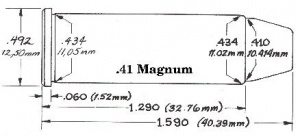.41 Remington Magnum
| .41 Remington Magnum | ||||||||||||||||||||||
|---|---|---|---|---|---|---|---|---|---|---|---|---|---|---|---|---|---|---|---|---|---|---|

| ||||||||||||||||||||||
| Dimensions for the .41 Magnum | ||||||||||||||||||||||
| Type | Revolver | |||||||||||||||||||||
| Country of Origin | USA | |||||||||||||||||||||
| Specifications | ||||||||||||||||||||||
| Case Type | Rimmed, straight | |||||||||||||||||||||
| Bullet Ø | .410 in (10.4 mm) | |||||||||||||||||||||
| Neck Ø | .434 in (11.0 mm) | |||||||||||||||||||||
| Base Ø | .434 in (11.0 mm) | |||||||||||||||||||||
| Rim Ø | .492 in (12.5 mm) | |||||||||||||||||||||
| Rim Thickness | .060 in (1.5 mm) | |||||||||||||||||||||
| Case Length | 1.290 in (32.8 mm) | |||||||||||||||||||||
| Full Length | 1.590 in (40.4 mm) | |||||||||||||||||||||
| Rifling twist | 1-18 1/2 in | |||||||||||||||||||||
| Primer | Large pistol | |||||||||||||||||||||
| Production & Service | ||||||||||||||||||||||
| Designer | Elmer Keith / Bill Jordan | |||||||||||||||||||||
| Design Date | 1964 | |||||||||||||||||||||
| Manufacturer | Remington Arms | |||||||||||||||||||||
| Ballistic Performance Sampling | ||||||||||||||||||||||
| ||||||||||||||||||||||
Contents |
[edit] Development
In 1963, Elmer Keith and Bill Jordan, with some help from Skeeter Skelton, petitioned Smith & Wesson, Remington, and Norma to produce a pistol and ammunition in .41 caliber which would fall between the extant .357 Magnum and .44 Magnum cartridges in ballistic performance, and at the same time address perceived shortcomings with those loads.[4]
The .357 Magnum suffered from restricted terminal ballistic effectiveness in the early 1960s, as jacketed hollow point bullets were not yet commonly available, and the manufacturer's standard loadings consisted of simple lead bullets. The powerful .44 Magnum, primarily a heavy hunting round, was considered overkill for police use, generating too much recoil for control under rapid fire. In addition, the revolvers chambered for the .44 were considered too large, bulky, and heavy for police carry.[4][5] Keith's original vision called for dual power levels in the .41, a heavy magnum load pushing a 210-grain (14 g) JHP at a muzzle velocity of 1300-1400 feet per second (ft/s), and a milder police loading which was to send a 200-grain (13 g) semiwadcutter downrange at around 900 ft/s.[4][5] These plans went awry due to an ongoing fascination in the firearms community with high-powered cartidges; Remington was swayed by its influence and instead of following Keith's blueprint chose to emphasize the performance of the new cartridge. As a result, the .41 "Magnum" load was released at an advertised 1500 ft/s, and even the "light" police loading was introduced with a 210 grain lead semiwadcutter "warmed up" to about 1,150 ft/s. Unfortunately, the police load as delivered was regarded as overpowered by most law enforcement agencies, many of whom were still using .38 Special revolvers.[4][5] Additionally, Smith & Wesson simply adapted their large N-frame revolvers for the new cartridge, which did not address size and weight concerns.[4][6] The Model 58, targeted for the law enforcement market, was introduced on July 10, 1964. Weighing in at 41 ounces, the Model 58 compared unfavorably with other popular revolvers available at the time, such as Smith's own 34 ounce Model 10 in .38 Special.[4] These combined factors mostly eliminated the .41 Magnum from consideration for its intended market as a law enforcement firearm, although it continued to be touted as such and was adopted by a few law enforcement agencies.[4][5] Smith & Wesson also produced a high-end, premium revolver in .41 Magnum caliber, the Model 57, almost identical to the .44 Magnum-chambered Model 29.[4]
[edit] Market reception
The .41 Magnum never enjoyed the popularity and success of either the .357 or .44 Magnum cartridges, but is still prized by handgun hunters as it generates noticeably lighter recoil and provides a flatter bullet trajectory at long range than the .44.[7] Nevertheless, the .44 Magnum still catalogs a greater variety of heavier bullet weight offerings which are more effective on larger game, and also boasts a slight edge in power when using the heaviest factory loads, or if pushed to the edge by handloading.[8]
[edit] See also
[edit] References
- ↑ Federal Cartridge Web site
- ↑ Remington Arms Web site
- ↑ Winchester Arms Web site
- ↑ 4.0 4.1 4.2 4.3 4.4 4.5 4.6 4.7 "Smith & Wesson's .41 Magnum", Free Patriot Web site. Accessed August 6, 2008.
- ↑ 5.0 5.1 5.2 5.3 Smith, Clint. "The .41 Mag: If only we could do it over", Guns magazine April 2005. BNET Web site. Accessed August 6, 2008.
- ↑ Taffin, John. "The .41 Magnum Turns 40 - The Sixgunner" American Handgunner magazine, Nov-Dec 2003. BNET Web site. Accessed August 6, 2008.
- ↑ "S&W Model 57", Notpurfect Web site. Accessed August 5 2008.
- ↑ "The .41 Magnum", Notpurfect Web site. Accessed August 5, 2008.